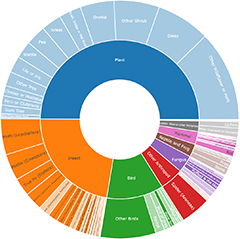Shelf-like to hoof-like & usually on wood
The fruitbodies of the fungi in this group grow from wood, but sometimes that wood may be buried. They range from fairly thin, shelf-like or bracket-like growths (with horizontal extent much greater than vertical thickness) to those that are very chunky (with vertical thickness equal to, or even greater than, horizontal extent).
In some species with shelf-like fruitbodies the shelves are wavy, rather than absolutely flat.
As well as the wholly shelf-like fruitbodies there are those that are flat sheet+shelf. These start as a flat growth on a downward facing surface (e.g. the lower side of a leaning trunk or of a fallen branch lying on the ground). After a while the upper edge of this sheet-like growth turns out from the wood to form a horizontal shelf. Technically such a composite growth form is described as effused-reflexed (effused: the sheet-like bit; reflexed: the shelf). In some species the shelf constitutes a significant proportion of the fruitbody and such species are included here.
There are other species that either remain flat on wood or where the margins of the mature fruitbody occasionally turn away from the wood, but very little and only to form a slight horizontal lip, with almost all of the mature fruitbody still the flat area. Look for those in Other fungi on wood.
Sometimes, understandably, you will be unsure whether you have a ‘shelf ‘or a ‘lip’. After all, a lip may be only an immature stage in the formation of a shelf. In a simple guide such as this, it is impossible to give a definitive answer for each case. The only possible advice is to look in each category and see if other features suggests a species or genus for your sighting.
Warnings
Some species which normally produce shelf-like to hoof-like fruitbodies can show considerable plasticity in fruitbody form, depending on where the fruitbody develops. For example, Pycnoporus coccineus (see the pored/maze-like sub-group) almost always produces shelf-like fruitbodies but you may find no more than a thick crust (seen on the underside of a ceiling) or an inverted, shallow cone (seen on the top side of a fallen branch). In such cases you would, quite understandably, look for a match to your sighting in some other category.
Announcements
Hello NatureMaprs!Three new priority species lists of exotic freshwater and terrestrial invertebrates, and vertebrates in the ACT have been added to NatureMapr. Uploading records of these species to N...
Continue reading
NatureMapr now receives more records in NSW than ACT
NatureMapr Data Collector 6.2.1 update
Critical nature positive infrastructure update
IMPORTANT NatureMapr Data Collector 6.2.0 mobile app update
Discussion
Phaeotrametes decipiens
Cerrena zonata
Top contributors
- trevorpreston 128
- Teresa 79
- Hejor1 78
- LisaH 41
- KenT 36
- Mike 35
- TimL 35
- AlisonMilton 33
- JackyF 32
- mahargiani 29
Top moderators
- Heino1 640
- Teresa 104
- Heino 81
- Pam 65
- MichaelMulvaney 52
- Csteele4 42
- JTran 36
- Heinol 29
- KenT 25
- CanberraFungiGroup 9



